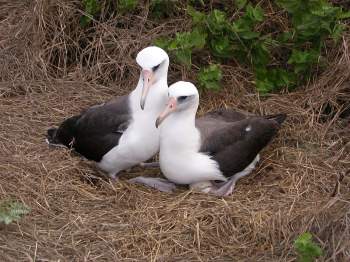
A breeding Laysan Albatross pair on Mexico's Clarion Island, photograph by Ross Wanless
Yuri Albores Barajas (CONACYT, Mexico City, Mexico) and colleagues have published open access in the journal Waterbirds on the conservation of Mexican seabirds, inc luding Black-footed Phoebastria nigripes and Laysan P. immutabilis albatrosses that breed on several of the country’s offshore islands.
The paper’s abstract follows:
“In Northwestern Mexico, approximately 40 breeding species of seabirds have been reported, with several threats (e.g., invasive species introduction and habitat loss) affecting the viability of their populations. As such, it is necessary to take action for their protection. To prioritize conservation activities, 119 reports (governamental [sic] agency monitoring programs, grey literature, and scientific literature) were analyzed for research and monitoring results from 1922-2018 (93 of 119 published after 1990) and ranked the different islands (91 sites, including archipelagos with multiple islands) based on their breeding seabird communities (35 species in 11 seabird families, including 7 endemic breeders). For the ranking exercise, three criteria were considered: conservation category, preferred habitat, and foraging guild for each species. Taking into consideration the breeding species on each island, an index to rank the islands was created. Ten islands or archipelagos have high conservation priority (index score > 10 = high priority; mean index = 4.7, median = 5.0, max = 17.9, n = 91), and the most important are: Revillagigedo and San Benito archipelagos, Coronado, San Lorenzo, and Natividad Islands. It is necessary to use new tools and techniques to determine populations' sizes and trends and to create a baseline to compare with future studies. Furthermore, many of the species breeding or feeding in the Mexican Economic Exclusive Zone migrate to other latitudes, elevating the conservation problem to an international scale.”
Reference:
Albores Barajas, Y., de la Cueva, H., Soldatini, C., Carmona, R., Ayala Pérez, V., Martinez-Gómez, J. & Velarde, E. 2020. Challenges and priorities for seabird conservation in northwestern Mexico. Waterbirds 43(1). doi.org/10.1675/063.043.0101.
John Cooper, ACAP Information Officer, 09 June 2020




 English
English  Français
Français  Español
Español 






